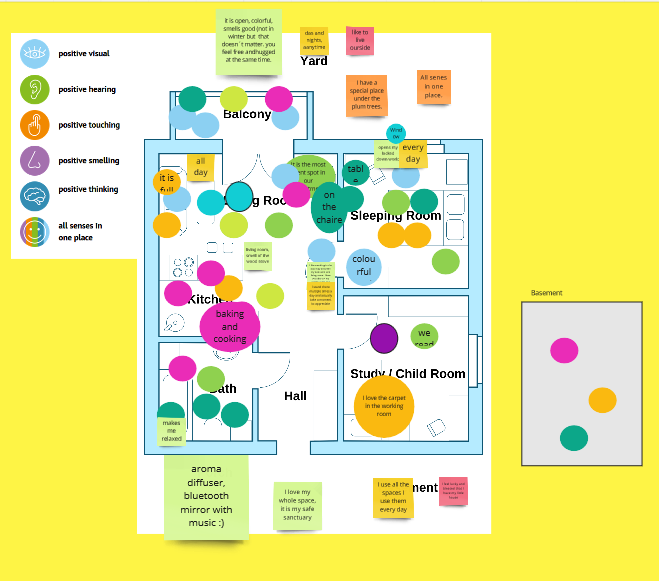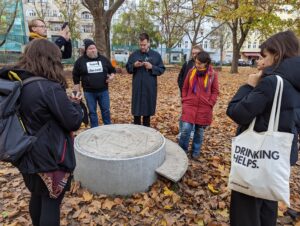Map your flat
EXPLORATION & KNOWLEDGE SHARING
“Map Your Flat” is an online adaptation of the “Map Me Happy” approach, designed to help participants reflect on their senses and map areas within their apartments where they experience positive sensations.
Short summary of the practice
“Map Your Flat” is an online adaptation of the “Map Me Happy” approach, designed to help participants reflect on their senses and map areas within their apartments where they experience positive sensations. The exercise encourages participants to identify places that evoke feelings of comfort, pleasant smells, pleasing sounds, and visually appealing aspects. By engaging in this activity, participants can create a mental map of their surroundings and gain a better understanding of the locations that contribute to their overall well-being.
Goal of the practice
Help participants reflect on their senses and map areas within their apartments.
Target group
During the exercise the participants had been trainers and community workers, however the exercise can be done in any online setting.
Number of participants: Unlimited
Age of participants: Young and Adults, 12+
Materials
- Phone
- Internet access
Method settings
The method has been developed as a tool that can be used for online meetings.
Duration
Time needed to add participants’ ideas to the platform.

Preparation
1-2 hours
Step by step guide
The practice was applied during a couple of online training sessions during the pandemic. In the sessions roughly 50 people participated.
The facilitator should prioritize the use of an interactive whiteboard tool, such as Miro, Padlet, Prezi, or similar platforms. The facilitator’s task is to create a representative floor plan of a typical apartment (refer to the provided photo), and color code the senses to be mapped. Sticky notes or post-its should be prepared in corresponding colors.
Once all participants are online, the facilitator should begin by explaining the concept of mapping the senses and present the floor plan. After addressing any questions or concerns, the participants should step away from their computers and take 15 minutes to explore their own apartments, mapping the various senses they experience. The individual sense points should then be collectively placed on the online floor plan.
Once everyone has “mapped” their points, the facilitator should provide 5 minutes for participants to explore all the sticky notes and then facilitate a brief feedback session. Participants should share how and why they chose their specific points on the map. Following approximately 5 minutes of discussion, the participants should write down their reflections on notes with the following prompts: 1. Why do they like the place? 2. How often do they use it? 3. Provide a conclusion: How do you perceive the place after the mapping exercise? Has anything changed, or is there something you would like to change?
After 10 minutes, the facilitator should review the post-its and allow participants time to share their reflections and insights. During the closing remarks, it should be emphasized that the exercise is intended to create a mental map or a person’s subjective perception of their area of interaction.
Expected output
The expected output of the “Map Your Flat” exercise is a collection of individual participants’ maps highlighting areas within their apartments where they experience positive sensory stimuli. Ideally, the results should be visually presented, either through an interactive online platform or through collated images, allowing for easy comparison and analysis.To ensure relevance and effectiveness, the maps should clearly indicate the specific locations within the participants’ flats that contribute to their well-being. The maps can use symbols, colors, or other visual cues to represent different senses such as comfort, pleasant smells, pleasing sounds, and visually appealing aspects.
DOs, DONTs and ethical considerations of the method
DOs of the method:
- Encourage participants to be specific and precise in marking the areas on their maps.
- Provide clear instructions and guidance on how to interpret and represent different senses.
- Facilitate a safe and inclusive environment where participants feel comfortable sharing their experiences.
- Encourage participants to reflect on the significance of each marked area and explain why it contributes to their well-being.
DONTs of the method:
- Avoid imposing judgments or predefined notions of what should be considered positive sensory experiences.
- Discourage participants from comparing or criticizing each other’s maps, as the exercise is subjective and personal to each individual.
Ethical considerations:
- Confidentiality: Respect the privacy of participants and ensure that their personal information or identifying details are kept confidential.
- Informed consent: Obtain informed consent from participants before engaging in the exercise and ensure they understand the purpose, potential outcomes, and any risks involved.
- Sensitivity to diversity: Acknowledge and respect diverse cultural, religious, and personal backgrounds that may influence participants’ sensory perceptions.
- Anonymity: If sharing the results publicly, ensure that participants’ identities are protected and that their maps are presented in an anonymous or pseudonymous manner.
- Emotional well-being: Recognize that the exercise may evoke personal emotions and experiences.
- Provide support mechanisms and resources for participants who may require additional assistance or guidance.It is crucial to prioritize the ethical considerations and well-being of participants throughout the exercise to create a safe and respectful environment for exploration and expression.
Change the method brings to the communities
The participants get aware of their own surroundings. They understand how certain things in their everyday life stimulate their senses and by this their wellbeing. After the mapping people can think how to increase the wellbeing around them. In an online setting, the method helps to create a sense for the place and connects people online, while doing a hybrid offline exercise.
Adaptation/Application of the method
The method could be put on plaction, partnership or citizen control. If it is on plavation and partnership, the facilitators can take over the shaping of solutions. However, the strength of the method can shine when the mapping is actually initiated by the citizens/participants themselves and then shared with the facilitators. Here the facilitator would rather have the task to review and comment on the implemented actions.
Credit, References, and Resources
“Map me happy” project FB page – https://www.facebook.com/profile.php?id=100080580520645
More about the “Map me happy” practice as a community mapping practice – https://www.motasdesign.com/map-me-happy-a-community-mapping-project/
Community mapping different examples:
A guide to community asset mapping for community groups and local organisations – https://ucanr.edu/sites/CA4-HA/files/206668.pdf
Community mapping toolkit – https://www.valeofglamorgan.gov.uk/Documents/Working/Regeneration/Rural%20Regeneration/community-mapping/community-mapping-booklet-web-english.pdf
Community Mapping Guide – https://www.hse.ie/eng/services/list/4/disability/reconnect/community-mapping.pdf
Place game (Tool to understand your street or square better and map its qualities) – https://placemaking-europe.eu/tool/place-game-manual/
https://placemaking-europe.eu/wp-content/uploads/2022/11/PE_Toolbox_-_PlaceGame-2018.pdf
Related posts

Active Citizenship
Active citizenship in this context refers to the power of individuals or small resident groups to proactively engage in community mapping exercises for improving their city or neighborhood.

ArcGIS Online
ArcGIS Online provides a cloud-based mapping and analysis solution. It is used to create interactive web maps, analyse data, share and collaborate.

Civic Alert
Civic Alert is a platform designed to facilitate communication between citizens and governments. Citizens can use their mobile application to report problems in the city to the authorities in three easy steps.
